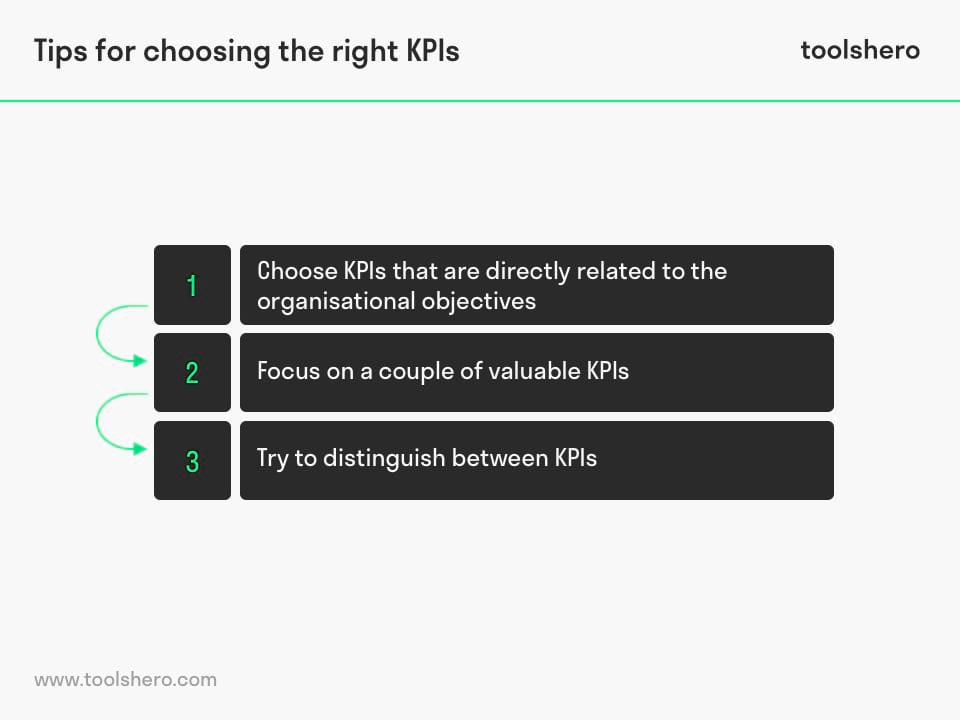Key Performance Indicators (KPIs)

Key Performance Indicators (KPIs): this articles provides a practical explanation of Key Performance Indicators (KPIs). Next to what this concept and defintion is, this article also highlights the effectiveness, the Characteristics of KPIs, the types of KPIs and 37 Key Performance Indicators examples which you can directly apply to optimise various business activities and tips on how many KPIs to use. After reading, you’ll have a basic understanding of this powerful quality management tool. Enjoy reading!
What are Key Performance Indicators (KPIs)?
The definition of Key Performance Indicators (KPIs) is that they are measurable indicators that show how a company is performing and whether it will achieve its organisational objectives.
Companies use KPIs at all levels of the organisation to evaluate performance and results.
Management-level KPIs often focus on the overall performance of a company, whereas low-level KPIs are used to evaluate supporting processes in departments such as Human Resource Management and Marketing.
KPIs offer a stronger focus on strategic and operational development, form a basis for decision-making, and help focus attention on issues that are important.
The exact indicators that are applied and monitored depends on the industry, department, and company objectives. After the most important business statistics have been determined, these can be recorded with a (real-time) reporting tool.
This gives everyone in the organisation insight into the current performance level. A commonly used reporting tool is the Balanced Scorecard.
Effectiveness of Key Performance Indicators
As we have seen, Key Performance Indicators (KPIs) are important performance indicators. Too often, however, organisations blindly adopt KPIs that are recognised by the industry, and then wonder why these KPIs do not encourage positive change and reflect their own organisation.
Although this aspect is often overlooked, KPIs are primarily a form of communication. It is therefore important to adhere to the general rules and best practices of other communication methods. Be concise, clear, and only include relevant information.
Another important aspect of effective use of KPIs is to ensure that employees and teams properly understand the basic principles of the organisational objectives and how they should be achieved.
Characteristics of KPIs
Generally speaking, there are two categories of KPIs. An indicator can only measure what has happened in the past. Each KPI that tries to predict something in the future is not an indicator, but a prognosticator.
Quantitative KPIs
These type of KPIs are the most common. KPIs based on quantitative data are measurable values without distortion by personal opinions, prejudices or interpretations. These are preferably measured and reflected against a standard value.
Qualitative KPIs
Qualitative KPIs are based on or influenced by personal feelings or opinions and are generally expressed as a numerical or textual value.
Below are several characteristics of a good Key Performance Indicators in the business world:
- KPIs are mainly presented in the form of numbers.
- KPIs must be well integrated with the business processes and objectives.
- To achieve the desired change, it must be possible to implement KPIs in practice.
If KPIs are created for the realisation of certain goals, the SMART criteria may also be applied:
- Is the goal specific?
- Can the KPI be used to measure progress?
- Is the goal achievable?
- How relevant is this goal for the organisation?
- Time-bound. In what time period must this goal be realised?
37 Key Performance Indicators examples
Always remember that Key Performance Indicators differ between companies and departments, but most can be divided into a number of categories.
Based on these categories, one can select the appropriate KPIs and combine them in a real-time dashboard or Balanced Scorecard. These tools are ideal for monitoring progress because of the ability to combine both organisational and strategic actions with business management, service management or quality management.
Examples of financial KPIs
- Average revenue. Determined by dividing the total turnover by the total sales moments.
- Profit. Profit is an important performance indicator, and is calculated by subtracting the total expenditure from the total turnover.
- Costs. Costs are the sum of all cost items combined. By measuring cost effectiveness, new ways can be discovered to keep costs low.
- COGS (Costs of Goods sold). These are all production and sales costs of a specific product. By keeping track of this, the actual profit margin can be calculated more accurately.
- Return on Investment. This is a parameter that evaluates the performance of a company by dividing the net profit by the total asset value.
Examples of marketing and customer KPIs
- Sales per region. By analysing this KPI, it is possible to better estimate why certain regions perform less well than others.
- Number of customers. Similar to the profit KPI, this is a simple indicator of the total number of customers.
- Market share. This KPI points to the market share that a product (or company as a whole) has achieved over a period of time.
- Customer acquisition costs. These are the total customer acquisition costs divided by the new number of customers in a specific period. This KPI helps to evaluate the cost effectiveness of marketing campaigns.
- CSAT (Customer Satisfaction Score). This is a qualitative KPI and is based on, for example, results of questionnaires that were conducted among customers. Such a KPI can also be expressed by means of a smiley.
- Customer retention. This is the percentage of customers who return to make new purchases.
- Net Promoter Score (NPS). NPS refers to the likelihood of customers referring one another to a particular company.
- Customer life time value. This KPI shows the expected turnover of a customer during their entire relationship with the company.
Examples of supply chain and operational KPIs
- Time to market. This KPI indicates the launch time of a product, from initial idea to launch.
- Lead time. This is the duration of a specific process.
- Out of stock (stockouts). The number of times or days that a product is not available for sale due to empty stock.
- Perfect orders. The percentage of orders that are error-free.
- Fill rate. The percentage of orders that were sent during first shipment.
- Transport costs per unit. This KPI measures the transport costs per product.
- Stock turnover speed. This is the number of times the inventory of a company is depleted each year.
Examples of HR Key Performance Indicators
- Employee Turnover. This is the replacement percentage of employees in relation to the numerical difference between new employees and redundancies.
- Pension ratio. This KPI refers to the percentage of the total workforce that has retired.
- Promotion vs external recruitment. This KPI shows the ratio between how many people receive promotion within a company versus the number of external recruitments.
- Salary Competitiveness Ratio (SCR). This is the ratio between the average company salary and the average salary offered by competitors or others in the sector.
- Turnover per employee. This is an indicator of the productivity of a company’s staff. It measures the amount of sales per employee. It is an important indicator of how efficiently human resources are applied.
- Employee satisfaction index. This KPI helps show how satisfied employees of a company or business unit are.
Examples of project management KPIs
- Cost of work done. This is a KPI that helps a project manager identify the actual costs of the activities that have been performed up to a certain point in time.
- Missed milestones. This helps the manager keep track of the percentage of tasks that have not been completed within a specified period.
- Estimation of total costs upon completion. This is the sum of the total costs so far (costs of work done), plus the estimated costs required to complete the remaining work.
- Management costs. This KPI is used to calculate periodic costs such as the salaries of employees.
Examples of social media KPIs
- Social media footprint. This KPI identifies the extent to which the organisation is present on various social media channels.
- Clicks. This value represents the number of clicks on certain website links.
- Likes. This KPI shows the number of likes on a message or product. Likes create more attention because people are attracted to things that are popular. More likes also means that a website or post is given a higher place in search engine results.
- Comments. The number of comments posted. Interesting content leads to conversation. Praise, criticism or general discussion; it is all useful for improving one’s marketing strategy.
- Profile visits. The number of times social media pages are visited.
- Active followers. The number of followers that a company has on its social media channels. A follower is considered active if he/she has registered within the past 30 days and has interacted with the company’s content.
How many KPIs should I use?
Although there is nothing intrinsically wrong with recording a large number of statistics, it is unrealistic to expect that they will all be thoroughly analysed. Moreover, too many Key Performance Indicators may result in an abundance of extra work and may cause confusion.
For this reason, put together a dashboard with the Balanced Scorecard and a number of KPIs that the teams and employees can realistically monitor and continuously respond to. Most KPIs do not have to be particularly detailed, but instead have to reflect the performance of the most vital business units.
The number of KPIs that should be applied depends on the level of the organisation and its general objectives.
How do I choose the right KPI?
There is no manual that describes how you should select the best KPIs. Below are some tips when selecting and applying KPIs.

Figure 1 – 3 tips for choosing Key Performance Indicators (KPIs)
Choose KPIs that are directly related to the organisational objectives
KPIs are measurable values that are used to measure business performance against the company’s commercial goals.
Goal 1: increase sales by 10% before the end of the financial year.
KPIs: sales figures, website traffic, conversion ratio
Goal 2: increase website traffic by 20%.
KPIs: website traffic, traffic sources
As can be seen, each of the KPIs is directly related to one of the business objectives.
Focus on a couple of valuable Key Performance Indicators (KPIs)
Each company and sector is different, so it is difficult to determine an exact number of Key Performance Indicators. However, for certain departments it is recommended to not use more than four to ten KPIs, depending on the size and complexity.
There are numerous KPIs, especially when it comes to marketing. This is because everything related to inbound marketing is often measured with highly detailed statistics software. Overviews, conversions, clicks, etc. are all automatically tracked. Less is more, however, also in this case. Instead of using dozens of statistics, you should focus on just a few KPIs.
Try to distinguish between KPIs
Although there are differences between qualitative and quantitative KPIs, there are also differences in what exactly a KPI represents. For example, one may demonstrate how a company has dealt with a certain issues in the past, whereas another shows how the company is performing currently. One is not necessarily better than the other, but it is important to understand the differences between the two.
KPIs that measure how a company has performed in the past measure the output of something that has already happened. This may relate to new customers or the total revenue in the previous year. These types of KPIs are only suitable for measuring results.
On the other hand, KPIs that show how a company is performing currently measure input, progress, and the probability of achieving a goal in the future. These types of KPIs therefore serve as predictors of what will happen if the organisation stays on the same course. Examples of such KPIs include website traffic and conversion ratio KPIs.
Traditionally speaking, companies often focus on Key Performance Indicators (KPIs) related to past performance. The reason for this is that these statistics are easy to track, as the corresponding events have already taken place.
It is very easy to prepare a report on the number of sales moments in the past quarter, for example. KPIs that reflect how the organisation is currently performing are more valuable, however, in the sense that they can serve as a basis for future business decisions.
Now it’s your turn
What do you think? Are you familiar with the explanation of Key Performance Indicators (KPIs)? Which KPIs are most important in your direct work environment? Do you believe companies are too dependent on statistics? Which KPIs would you implement in your company? Do you have any valuable KPIs you’d like to share with us in the comments section below? Do you have any other tips or additional comments?
Share your experience and knowledge in the comments box below.
More information
- Chan, A. P., & Chan, A. P. (2004). Key performance indicators for measuring construction success. Benchmarking: an international journal.
- Chae, B. K. (2009). Developing key performance indicators for supply chain: an industry perspective. Supply Chain Management: An International Journal.
- Parmenter, D. (2015). Key performance indicators: developing, implementing, and using winning KPIs. John Wiley & Sons.
- Shahin, A., & Mahbod, M. A. (2007). Prioritization of key performance indicators. International Journal of Productivity and Performance Management.
How to cite this article:
Janse, B. (2020). Key Performance Indicators (KPIs). Retrieved [insert date] from Toolshero: https://www.toolshero.com/quality-management/key-performance-indicators/
Published on: 07/12/2020 | Last update: 01/19/2023
Add a link to this page on your website:
<a href=”https://www.toolshero.com/quality-management/key-performance-indicators/”>Toolshero: Key Performance Indicators (KPIs)</a>












